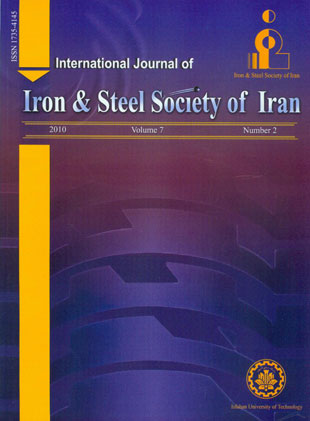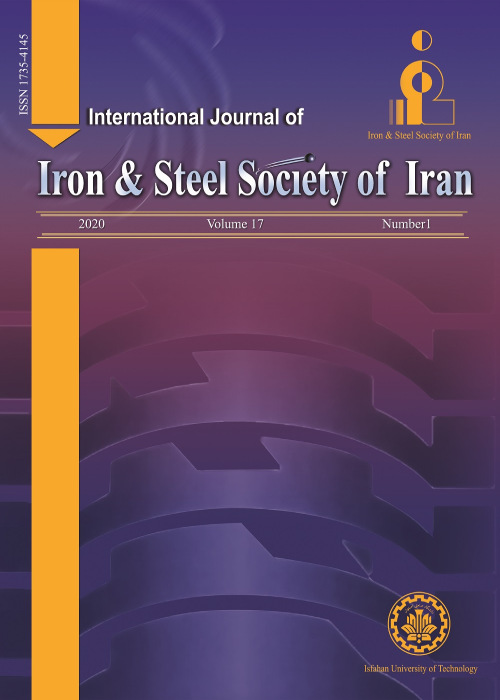فهرست مطالب

International Journal of iron and steel society of Iran
Volume:7 Issue: 2, Summer and Autumn 2010
- 46 صفحه،
- تاریخ انتشار: 1390/11/05
- تعداد عناوین: 7
-
-
Page 1Producing parts with high density and improved mechanical properties is one of the most important aims of powder metallurgy process. There are many factors for attaining modified properties in sintered parts but among them controlling type and quantity of alloying elements and manufacturing parameters such as compacting pressure, sintering temperature are the most effective.In this research, two series of Cr-Mo prealloyed powders with 1.5% and 3% chromium contents were used, and then influences of manufacturing parameters on physical and mechanical properties were investigated. The results show that by compacting pressure and sintering temperature increment and chromium content decrement, densityis increased and subsequently physical and mechanical properties of low alloyed sintered steels are improved.
-
Page 6Bainitic transformation at low transformation temperatures leads to a microstructure involving fine plates of bainitic ferrite and thin films of retained austenite. This microstructure has shown ultimate tensile strength of about 2.2 GPa, noticeable uniform elongation in the range of 5 to 30%, hardness values of about 600 to 670 HV and impact toughness in the range of 30 to 40 MPa m1/2. With careful design of the chemical composition of steel, suitable mechanical properties with lower cost production could be achieved. In the current work, the microstructure and mechanical properties of two steels with different chemical compositions have been evaluated using XRD, SEM, TEM, tensile and Charpy impact tests. The results of this study suggest that without trial and error, it is possible to design a new steel with unique microstructure and mechanical properties. The achieved mechanical properties are due to the microstructural characteristics which evolved during isothermal transformation.
-
Page 12Cryogenic treatment can be used as a supplemental treatment that is performed on some tool steels between quenching and tempering as an effective method for decreasing retained austenite and increasing wear resistance. In this research, the effect of deep cryogenic treatment (DCT) on dimensional stability and mechanical properties of 80CrMo12 5 tool steel was investigated. The martensitic transformation start and finish temperatures were also studied using dilatometry tests. The results show that the start and finish temperatures of the martensitic transformation are 254°C and - 87°C, respectively. The hardness increases (untempered) by 3 HRC after DCT. Thus, to decrease or eliminate the amount of retained austenite, cryogenic treatment is necessary. In DCT, impact energy and hardness at all tempering temperatures decreases and increases, respectively. Tempering transformations investigation using dilatometry tests, verified that the DCT increases dimensional stability. This is attributed to the transformation of retained austenite to martensite.
-
Page 18X-ray diffraction peak profile analysis was used to identify changes in the lattice distortions during isothermal aging of Fe-10Ni-7Mn (wt. %) maraging steel. Integral peak breadths were analyzed using classical Williamson-Hall equation taking the elastic anisotropy into account. It was found that substantial lattice distortions rise during precipitation hardening which depend strongly on the specific Young’s modulus of a given crystallographic direction. After normalizing by elastic stiffness, the magnitude of average lattice distortions increased reasonably in accordance with age hardening.
-
Page 21In the present research, friction stir welding (FSW) process was used for butt joining of pure copper plate to 316L stainless steel plate. Mechanical properties and microstructural characteristics of the joint were evaluated by microhardness and tensile tests as well as optical and scanning electron microscope (SEM). It was found that microstructure of the weld nugget (WN) has fine grains whereas the elongated grains are located in the thermo mechanically affected zone (TMAZ) into 316L stainless steel. Also, coarse grains are observed in the heat affected zone (HAZ) into pure copper. The microhardness values of the WN are much higher than the base metals. The HAZ zone shows minimum hardness values. The butt joint has 85% weld efficiency compared to the copper base meal.
-
Page 26The effect of mechanical activation on structural changes and kinetics of carbothermic reduction of hematite with graphite was studied in this research. Hematite powder mixture with graphite (with stoichiometry ratio C/O=1) was milled for the time periods of zero to 50 hours, and the structural changes were studied using X ray diffraction (XRD). The effect of mechanical activation on the kinetics of hematite carbothermic reduction was studied by performing thermal analysis tests and by employing model-free and constant slope methods. The activation energy as well as the reaction mechanism was then determined. The results showed that by mechanical activation for a time period of 50 h, the activation energy is decreased from 387 kJ/mol-1 to 186 kJ/mol-1, and the starting temperature of the reaction is decreased from 1125 to 620°C. The Boudouard chemical reaction was determined as the rate controlling step.
-
Page 34A new simple analytical model for prediction of cooling rate in the solidification process based on the local heat flux density extracted during solidification is introduced. In the modeling procedure, a solidifying control volume is considered in the mushy zone in which a heat balance equation is used to derive the present model. As the local heat flux density is a measurable parameter, the present model can be used directly on a production line. The present model was validated with numerical method and well adopted with analytical model of Garcia et al. The validation depicted that the present model can predict the cooling rate during solidification process with the same accuracy of the numerical method and Garcia’s model. Moreover, it was shown that the present model can be used to calculate the average and local cooling rate, where the available models face some difficulties.


